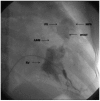Characteristics of double-chambered right ventricle in adult patients
- PMID: 20526387
- PMCID: PMC2880687
- DOI: 10.3904/kjim.2010.25.2.147
Characteristics of double-chambered right ventricle in adult patients
Abstract
Background/aims: This study evaluated the clinical features of double-chambered right ventricle (DCRV) in adults. Most cases of DCRV are diagnosed and treated during childhood. Consequently, very few reports include cases in which its clinical characteristics are evident in adults.
Methods: We reviewed the clinical data for 10 adult patients (age > or = 18 years) with DCRV.
Results: Electrocardiogram showed right ventricular hypertrophy in 3 DCRV patients. All cases were associated with ventricular septal defect (VSD; 7 for perimembranous, 2 for muscular outlet, and 1 for the subarterial type). Surgical correction was done for 7 DCRV patients all of whom survived operations. Their follow-up echocardiogram showed the pressure gradient in their right ventricle was significantly decreased from 69.4 +/- 17.2 mmHg preoperatively to 10.2 +/- 5.0 mmHg postoperatively (p < 0.05). In the short-term follow-up, there was no significant increase in the pressure gradient in the right ventricle.
Conclusions: There are lots of cases of DCRV that are not diagnosed accurately in adults. In our experience, all DCRV cases had VSD and surgical correction of these cases showed excellent results. Therefore, accurate diagnosis of DCRV is necessary so that DCRV is not overlooked and operations are enabled within an appropriate time.
Keywords: Double outlet right ventricle; Heart defects, congenital; Heart ventricles; Ventricular outflow obstruction.
Conflict of interest statement
No potential conflict of interest relevant to this article was reported.
Figures




References
-
- Alva C, Ho SY, Lincoln CR, Rigby ML, Wright A, Anderson RH. The nature of the obstructive muscular bundles in double-chambered right ventricle. J Thorac Cardiovasc Surg. 1999;117:1180–1189. - PubMed
-
- Lucas RV, Jr, Varco RL, Lillehei CW, Adams P, Jr, Anderson RC, Edwards JE. Anomalous muscle bundle of the right ventricle: hemodynamic consequences and surgical considerations. Circulation. 1962;25:443–455. - PubMed
-
- Wong PC, Sanders SP, Jonas RA, et al. Pulmonary valvemoderator band distance and association with development of double-chambered right ventricle. Am J Cardiol. 1991;68:1681–1686. - PubMed
-
- Cabrera A, Martinez P, Rumoroso JR, et al. Double-chambered right ventricle. Eur Heart J. 1995;16:682–686. - PubMed
-
- Cil E, Saraclar M, Ozkutlu S, et al. Double-chambered right ventricle: experience with 52 cases. Int J Cardiol. 1995;50:19–29. - PubMed
MeSH terms
LinkOut - more resources
Full Text Sources
